Rust Family Foundation: Archaeology Grants Program
The Cotzumalhuapa Obsidian System:
Procurement, Production, and Provisioning in a Classic Mesoamerican Polity
[RFF-2018-83]Principal Investigator: David McCormick
Department of Anthropology, Yale University.
This project explores the importance of obsidian at Cotzumalhuapa, a Late Classic (ca. AD 650-950) Mesoamerican polity. Cotzumalhuapa is located in the Central Guatemalan Coast, north of and abutting the modern city of Santa Lucia Cotzumalguapa (fig.1). Obsidian underwrote society on the Pacific coast of Mesoamerica, as it was used by every household and other sources of ‘tool-grade’ stone, such as chert, are absent on the landscape (Stark et al. 2016).
Surface survey and excavations have demonstrated the presence of seven major production areas or workshops of obsidian artifacts at Cotzumalhuapa. Geochemical sourcing of obsidian recovered from these workshops, across the Cotzumalhuapa, and at neighboring sites demonstrates t
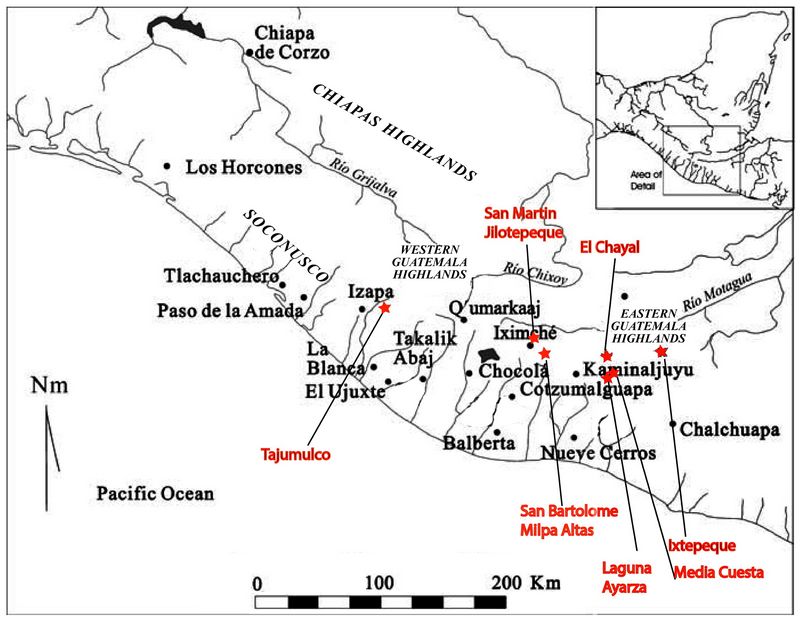 he presence of at
least six obsidian sources within the Cotzumalguapa polity. The
workshops were presumably in coeval operation, which challenges
centralized economic models popular for this region and time period.
Moreover, the unequal distribution of obsidian sources at workshops and
habitational contexts suggests that workshops and households procured
obsidian independently of a centralized authority.
he presence of at
least six obsidian sources within the Cotzumalguapa polity. The
workshops were presumably in coeval operation, which challenges
centralized economic models popular for this region and time period.
Moreover, the unequal distribution of obsidian sources at workshops and
habitational contexts suggests that workshops and households procured
obsidian independently of a centralized authority.Fig. 1: Map of Pacific Coastal Mesoamerica. Archaeological sites are indicated by black dots; obsidian sources found at Cotzumalhuapa indicated by red stars (adapted from Love 2007, fig.1).
Previous Work at the Site:
Habitation at Cotzumalhuapa began in the Middle Formative (ca. 600 BC; Parsons 1967). Just over a millennia later, around AD 650 the site would rise to prominence, growing to become one of the great cities of southern Mesoamerica. Settlement was arrayed around the monumental architectural compounds of El Baúl, El Castillo, and Bilbao (fig.2). Once thought to be discrete sites, investigations have demonstrated these compounds to be connected by a network of stone paved causeways and continuous settlement constituting the Cotzumalhuapa nuclear zone (CNZ) (Chinchilla Mazariegos, et al. 2005). The causeway network, which included a number of stone bridges, integrated the city’s urban core and extended into its’ hinterland (Chinchilla Mazariegos 2018). Cotzumalhuapa is best known for its distinctive sculptural tradition which spread throughout much of southern Guatemala (Chinchilla Mazariegos, et al. 2009; Parsons 1967; Thompson 1948).
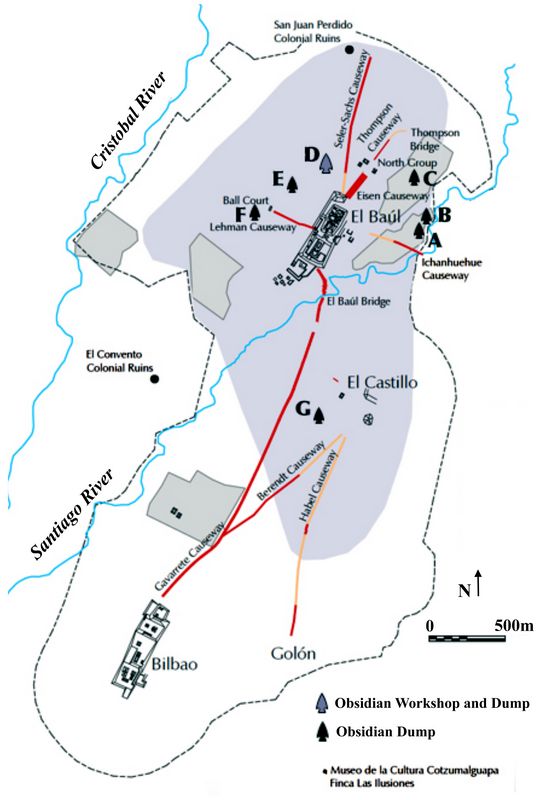 Surface
survey by Chinchilla (Chinchilla Mazariegos 2011b; Chinchilla
Mazariegos and Carpio Rezzio 2003) and rescue excavations by Frederick Bove
demonstrated the presence of several deposits of obsidian debitage.
These deposits represent workshop dumps involved in large-scale
specialized craft production of two obsidian industries: 1) prismatic
blades and 2) projectile points (fig.2). The largest is located near
the El Baúl acropolis, and covers 3,120 square meters. Excavations
produced comingled debitage from both industries, with raw materials
imported from the San Martín Jilotepeque and El Chayal sources (fig.1)
(Castillo Taracena 2006; Chinchilla Mazariegos and Carpio Rezzio 2003;
McCormick 2019). Rough earthen platforms were identified as probable
workshop loci.
Surface
survey by Chinchilla (Chinchilla Mazariegos 2011b; Chinchilla
Mazariegos and Carpio Rezzio 2003) and rescue excavations by Frederick Bove
demonstrated the presence of several deposits of obsidian debitage.
These deposits represent workshop dumps involved in large-scale
specialized craft production of two obsidian industries: 1) prismatic
blades and 2) projectile points (fig.2). The largest is located near
the El Baúl acropolis, and covers 3,120 square meters. Excavations
produced comingled debitage from both industries, with raw materials
imported from the San Martín Jilotepeque and El Chayal sources (fig.1)
(Castillo Taracena 2006; Chinchilla Mazariegos and Carpio Rezzio 2003;
McCormick 2019). Rough earthen platforms were identified as probable
workshop loci. Fig 2: Map of the Cotzumalhauapa Nuclear Zone indicating locations of obsidian dumps (drawn by author).
Excavations also revealed an adjacent architectural group comprised of residential and ceremonial buildings (Chinchilla 2011b). The scale of the deposits and the adjacent buildings, combined with their location in proximity to the El Baúl acropolis, suggests that the industry was closely related to and perhaps controlled by the Cotzumalhuapa ruling elite. However, surface survey revealed the presence of no less than six smaller deposits of obsidian debitage at locations that were probably domestic, suggesting the presence of smaller scale lithic production at the household level.
Current Project (RFF-2018-83)
Goals:
Assessment of obsidian’s role in the economy of ancient Cotzumalhuapa is accomplished by investigating the nature, intensity, and scale of three related topics: 1) long-distance exchange of obsidian, 2)production of obsidian tools, and 3) distribution of finished tools within the CNZ and Cotzumalhuapa’s hinterland. This project adopts Hirth’s (2006) concept of obsidian systems integrating these topics to understand them as part of a multi-tiered processes embedded within a network of social, political, and economic relationships concerned with the mining, transformation, and transportation of commodities over space.
Methodology:
Excavations in 2018, funded by Yale University, concentrated on previously unexplored dump-A and associated architectural features. Laboratory analysis on excavated materials, comprising the current project (RFF-2018-13), performed the following investigations:
1. Long-distance exchange was assessed through geochemical data gathered via X-ray fluoresence on archaeological artifacts recovered from Cotzumalhuapa and hinterland sites compared with reference samples.
2. Assessing the organization of specialized obsidian craft production was approached through a technological assessment of obsidian artifacts and manufacturing waste.
3. Investigating the distribution of finished tools in the CNZ and Cotzumalhuapa’s hinterland was accomplished through analysis of materials from 2018’s and previous excavations near the ball court of El Baúl, the El Baúl north group, the La Gloria group, Bilbao, and the peripheral sites of Finca San Cristobal, and Palo Verde.
4. Experimental work on obsidian tool use was also conducted for future comparative studies with artifacts in the collection.
Critical to assessing the organization of the obsidian system at Cotuzmalhuapa is contextualizing the location, tempo, and timing of obsidian in the various aspects of the obsidian system mentioned above. This was done through a documentation of architecture associated, ceramic analysis, and analysis of ground stone tools found in near the obsidian dumps.
Results from current project:
Excavations:
Field work was carried out from January 5 to March 23, 2018. Beginning with a ground penetrating radar (GPR) survey the area surrounding dump-A, which became operation number EB14. This was followed by a campaign of 90 shovel tests pits (STPs): each shovel test was 10m apart, 50cm in diameter and dug to a depth of 1m unless impeded by stones or other archaeological features. A series of excavation units were opened to further explore possible features revealed by GPR survey and shovel testing.
Operation EB14 was subdivided into four quadrants and seven locations were selected for the excavation of 2m x 2m excavation units. Two of these units (Q3F13 and Q4S10) encountered architectural features and were expanded to more fully expose them. Units Q4O3 and Q4J5 were excavated particularly because of the density of obsidian debitage encountered during the STP campaign.
Unit Q3F13 was originally opened to investigate the context of a well-conserved ceramic vessel found during the STP campaign. It was expanded to include a total of fifteen units of varying sizes, making it the longest horizontal exposure of the 2018 field season, uncovering Structure E (fig.3).
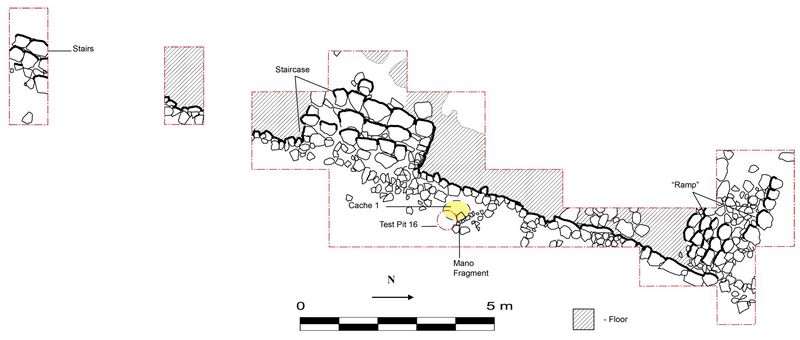
Fig.3: Plan view of Structure E (drawing by author).
Excavations exposed the East wall of the structure which ran between 34o and 36o east, facing the El Baúl acropolis. The exposed wall was constructed of river cobbles, many of which were quite large, each with their plainest edge facing west (fig.4). A four-tier staircase, measuring 3.25m i
 n width, with a (stair height) of
0.30-0.40m, was exposed in the middle of the wall. Three small units
(Q3I15, Q3K15, & Q3K16) confirmed continuation of the wall to a
minimum of 20m, unfortunately a modern agricultural ditch likely
destroyed any construction further southwest. Excavations in Q3F13
unearthed a cache of ceramic vessels (see Cache 1 below).
n width, with a (stair height) of
0.30-0.40m, was exposed in the middle of the wall. Three small units
(Q3I15, Q3K15, & Q3K16) confirmed continuation of the wall to a
minimum of 20m, unfortunately a modern agricultural ditch likely
destroyed any construction further southwest. Excavations in Q3F13
unearthed a cache of ceramic vessels (see Cache 1 below).Fig.4:. Arial photo of Structure E, from the west.. Image courtesy of the Kaminaljuyu Arqueological Project (photo by Javier Estrada).
Unit Q4J5 was originally excavated because of the density of obsidian encountered at approximately 0.80m below the surface during the STP campaign. However, the obsidian was a small, discrete deposit. The remnants of a building, designated Structure C, as well as some other interesting features were found in this unit. The interpretation of Structure C comes from two aligned stones in the southeast corner of the unit, coinciding with a lense of compacted soil (˜0.10m thick), possibly a floor, visib
 le in all four walls of the excavation (fig.5).
At about the same depth as this floor a feature of small stones
arranged in two concentric circles was encountered. Originally
interpreted as a hearth, excavation recovered no charcoal or evidence
of fire.
le in all four walls of the excavation (fig.5).
At about the same depth as this floor a feature of small stones
arranged in two concentric circles was encountered. Originally
interpreted as a hearth, excavation recovered no charcoal or evidence
of fire. Fig.5: Profiles of Q4J5 (drawn by Erika Gomez).
Below the level of the floor and adjacent to this circular feature a cache of ceramic vessels was encountered (see cache 2 below). A second discrete deposit of obsidian was encountered below the floor along the east wall of the excavation at about the same level as the one encountered during the STP campaign.
Unit Q4S10 was expanded to include thirteen units of varying size, exposing parts of two buildings designated Structures A and B, with a patio between them (fig.6). The conserved remnants of these buildings were smaller and of lower quality construction than Structure E. They were in close proximity of Q4O3, which was the principal component of dump-A that was excavated.
Excavations of Structure A exposed 6.80m of a wall with a maximum height of 0.80m. A centrally located single-stepped stairway, 2.0m in width and 0.30m grants access to the patio to the south.
 The east and south walls of Structure B were exposed. The east
wall faces the patio and measures 7m with a height of 0.45m. Five
meters, with a maximum height of 0.40m, of the southern wall were
exposed. At the westernmost unit a stair leading down to compacted
earth was found. Additionally, to the south of this wall a stone
pavement was located. Unfortunately, time constraints did not allow
further exploration of these features.
The east and south walls of Structure B were exposed. The east
wall faces the patio and measures 7m with a height of 0.45m. Five
meters, with a maximum height of 0.40m, of the southern wall were
exposed. At the westernmost unit a stair leading down to compacted
earth was found. Additionally, to the south of this wall a stone
pavement was located. Unfortunately, time constraints did not allow
further exploration of these features.Fig.6: Plan view of Structures A and B with references to floors (drawn by Erika Gomez).
The saturation of obsidian debitage in Q4O3 was such that it was dug using special protocol. After the first two 0.20m levels, each subsequent level was dug in 0.10m half-le
 vels (3.1, 3.2, 4.1, 4.2, etc.). Each of these
levels was excavated in 1m x 1m quadrants. For each half level of each
quadrant a 25 lb bag soil sample was removed for flotation in the
lab. Due to time constraints, the final nine half-levels were only
removed from the southwest quadrant, so as to reach sterile soil
(fig.7).
vels (3.1, 3.2, 4.1, 4.2, etc.). Each of these
levels was excavated in 1m x 1m quadrants. For each half level of each
quadrant a 25 lb bag soil sample was removed for flotation in the
lab. Due to time constraints, the final nine half-levels were only
removed from the southwest quadrant, so as to reach sterile soil
(fig.7). Fig.7: Unit Q4O3 west and north profiles, indicating levels of obsidian saturation (drawn by author).
During the excavation a number of lenses of compacted earth were encountered, however they never covered the entire excavatio
 n unit
and obsidian saturation was not
interrupted (fig.8). Notably, one of
these lenses occurred in the northeast quadrant between 2.03-2.1m,
below
which was found a concentration of ceramic vessels in variable stages
of conservation with an abundance of very thin
needle-like prismatic blades. These blades exhibited no
macroscopic use-wear, In the northeast quadrant, at 1.80m below the
datum,
an alignment of articulated stones was encountered, possibly
representing the corner of a building. Obsidian saturation to the
northeast of these stones below 1.80m decreases quickly to near
absence, suggesting that these stones delimited dump-A (figs.7 and 8).
n unit
and obsidian saturation was not
interrupted (fig.8). Notably, one of
these lenses occurred in the northeast quadrant between 2.03-2.1m,
below
which was found a concentration of ceramic vessels in variable stages
of conservation with an abundance of very thin
needle-like prismatic blades. These blades exhibited no
macroscopic use-wear, In the northeast quadrant, at 1.80m below the
datum,
an alignment of articulated stones was encountered, possibly
representing the corner of a building. Obsidian saturation to the
northeast of these stones below 1.80m decreases quickly to near
absence, suggesting that these stones delimited dump-A (figs.7 and 8).Fig.8: Plan view of Unit Q4O3 indicating various levels of compacted soil (drawn by author).
Laboratory Analysis:
The laboratory season commenced on April 2 and continued through September 28, 2018 and consisted of three major components: ceramic analysis, chipped stone tool analysis, and ground stone tool analysis. Additionally, flotation of soil samples collected from Q4O3 and other selected contexts was done to collect material for botanical analysis and the collection of carbon for 14C radiocarbon dating, and heavy fractions of obsidian to serve as representative samples of obsidian debitage. A portable DinoLite microscope (model AM4815ZT) proved invaluable in the identification of viable charcoal samples for radiocarbon dating and the creation of a database for ceramic pastes and usewear of lithic materials. Radiocarbon dating of the botanical samples obtained from flotation securely dated obsidian workshop dump-A.
Ceramic Analysis:
The ceramic chronology of the Central Guatemalan Coast is not straightforward. The majority of ceramic types found at Cotzumalhuapa come from two ceramic phases: San Jerónimo (400-950 A.D.) and Pantaleón (650/700-950 A.D.). The issue is that types from the San Jerónimo phase are in use early and persist through the Pantaleón phase, while some types are only made during the Pantaleón phase. Excavations during the 2018 season collected intermingled San Jerónimo and Pantaleón ceramics, suggesting the contexts are Late Classic in date. Radiocarbon dates from material collected during the 2018 season confirm this.

A total of 15,916 ceramic sherds were analyzed during the 2018 season, representing ceramics from the Middle Formative (900/800-600 B.C.) to the Colonial Period (after AD 1524). Twelve percent (n=1922) of the sherds recovered were unidentifiable. The majority of the identifiable material (n=13,994; 87.9%) consist of ceramics attributable to the San Jerónimo and Pantaleón phases (n=13,833; 86.9%), consistent with the predominantly Late Classic occupation of Cotzumalhuapa. Only 16 sherds were attributable to the Middle (n=2) and Late Formative Period (n=14). One hundred forty-two sherds attributable to the Postclassic were recovered, all of which came from the upper levels of excavations. Three sherds from the colonial period were also recovered.
Fig.9: Vessel 1, Cache 1 (photo by Gilberto Cruz).
A variety of complete, semi-complete, and fragments of non-vessel ceramics were also recovered during the 2018 season including: 549 figurine fragments, 32 spindle-whorls, 11 whistles, 3 rings, 2 small spheres, 3 beads, 1 mold, and 1 stamp. These artifacts were recovered throughout the EB14 but were clustered in the STPs and Units of Structures A and B, and Unit Q4O3.
Material recovered from operation EB-14 consisted of a significant presence of fine wares, especially Tiquisate, Congo, and Barranquilla types. These types include complex designs of anthropomorphic and zoomorphic characters, and geometric designs. Unit Q4O3, which accounted for 25.43
 % (n=4017)
of the total ceramics recovered, included seven semi-complete vessels.
Interestingly, two fragements of a Tiquisate vessel were found in two
different excavations (Q1AA3 and Q3H14) which are 60m apart. Similarly,
two fragments of a San Juan Plumbate vessel were found at approximately
1m of depth in units Q4R6 and Q4O3.
% (n=4017)
of the total ceramics recovered, included seven semi-complete vessels.
Interestingly, two fragements of a Tiquisate vessel were found in two
different excavations (Q1AA3 and Q3H14) which are 60m apart. Similarly,
two fragments of a San Juan Plumbate vessel were found at approximately
1m of depth in units Q4R6 and Q4O3.Fig.10: Vessel 2 (left) and Vessel 3 (right), Cache 1 (photos by Gilberto Cruz).
Special Deposits:
Cache-1 was recovered from Q3F13, and consisted of three well-preserved vessels found to the north of the staircase within Structure E. Vessel 1 is a well-preserved vase with a painted and incised design of a plump (possibly pregnant) dancing monkey (fig.9). Vessels 2 and 3 are decorated with geometric motifs (fig.10). Removal of the soil for flotation of Vessel 1 recovered a single obsidian blade. The contents of these vessels await further analysis.
Cache 2 was recovered from Q4J5 and consisted of three vessels found on the edge of a circular feature. Vessel 4 is a well-preserved, near-complete incised vessel with
 the repeating design of bird’s head with open beak
in profile, alternating with a f ull-bodied character, possibly a
rabbit, in profile with his arms over his legs (fig.11). Vessel 5
is a complete black and orange bowl, and Vessel 6 is a similar
fragmented bowl with incisions around the rim.
the repeating design of bird’s head with open beak
in profile, alternating with a f ull-bodied character, possibly a
rabbit, in profile with his arms over his legs (fig.11). Vessel 5
is a complete black and orange bowl, and Vessel 6 is a similar
fragmented bowl with incisions around the rim.Fig.11: Vessel 4, Cache 2 (photos by Gilberto Cruz).
Lithic Analysis:
The obsidian recovered during the 2018 field season is still in the process of being analyzed. Nevertheless, significant progress was made in the reconstruction of Cotzumlhuapa’s obsidian system using this material and material from previous excavations. Obsidian was analyzed with two methods.
First, the PI and students from the City University of New York and Yale University classified obsidian artifacts technologically according to the methods described by Clark (1997; Clark and Bryant 1997) and Hirth (Hirth, et al. 2006). Classification and measurements of weight, length, width, and thickness were taken on 2,973 previously unanalyzed pieces of obsidian. Second, XRF data was collected using an Olympus portable X-ray fluorescence spectrometer (XRF) on a total of 3,210 pieces of obsidian. Analysis of the ground stone tool assemblage of EB-14 has enriched understanding of the context in which obsidian production occurred.
Ground Stone Technological Analysis:
A total of 33 ground stone tools were identified in operation EB-14 including: manos, hammerstones, burnishers/polishers, centrally perforated stones, and axes. In general these tools are domestic in function and would be used for subsistence practices such as food preparation or household crafts. Notably, the majority of these tools were recovered in the area of Structures A and B. Three of these artifacts were clustered in Q4R6. Four examples had traces of an intense red pigment and were likely used for grinding specular hematite.
Chipped Stone Technological Analysis:
The Cotzumalhuapa workshops were involved in two major industries: 1) prismatic blades, which are widely distributed throughout the site, and 2) projectile points, whose distribution was restricted. In order to classify finished products and diagnostic debitage the author and Dr. Zac Hruby created a reference collection from material excavated from dump-D. The author and Dr. John Clark augmented this collection through experimental work collecting both debitage and manufactured objects from both industries in 2018.
Obsidian artifacts recovered from Structure E were analyzed in their entirety (n=1650). These artifacts consisted primarily of blades (74.72%), the vast majority of which were third s
 eries (66.9%). However, Structure E did
have examples of bifacial thinning flakes (5.08%), and unidentified pressure
flakes (8.5%), attesting to the production of projectile points at or
near the structure.
eries (66.9%). However, Structure E did
have examples of bifacial thinning flakes (5.08%), and unidentified pressure
flakes (8.5%), attesting to the production of projectile points at or
near the structure. Although the entirety of obsidian collected from Structures A and B could not be investigated during this lab season, a representative sample of 591 pieces were selected for analysis. Technologically, there was a shift away from finished products to production evidence. Blades from Structures A and B totaled only 55.53%, and third series blades dropped to 51.79%. Thinning flakes made up 12.91% and unidentified pressure flake made up 30.22% of this assemblage. Comparison of these two contexts demonstrates a decrease in the frequency of blades that coincides with an increase in flakes, presumably related to an emphasis on production at Structures A and B.
Table 1: Weights of obsidian recovered by level from Q4O3.
Obsidian accumulated from dump-A, unit Q4O3 weighed 293.38kg (Table 1; not including heavy fractions from floatation). Heavy fractions of obsidian artifacts and debitage from soil samples serve as representative samples of each level and quadrant. These heavy fractions are size graded using 1/4”, 1/8”, and 1/16” mesh. Thus far the analyzed contexts average approximately 95% debitage and 5% prismatic blades. Because of the low amount of waste produced in prismatic blade production this suggests that most of the waste was involved in the production of projectile points. This assertion is based on the low relative frequency of prismatic cores and identifiable core errors compared to that of identifiable thinning flakes and unidentified flakes.
X-Ray Fluorescence Spectroscopy
Comparison of the frequencies of obsidian from various sources from various contexts allows for investigation of mechanisms of exchange at various scales. Six sources of obsidian have been identified at Cotzumalhuapa and sites in its hinterland via XRF. Thus far, all of the contexts analyzed are dominated by either El Chayal (CHY) or San Martin Jilotepeque (SMJ) and many contain small amounts of obsidian from San Bartolome Milpas Altas (BMA), Ixtepeque (IXT), Laguna Ayarza (LGA), and Media Cuesta (MDC). No material has been positively identified as coming from Honduran or Mexican sources.

Fig.12: Pie chart of relative proportions of source material at Cotzumalhuapa obsidian dumps. BMA=San Bartolome Milpas Altas, CHY=El Chayal, IXT=Ixtepeque; SMJ=San Martin Jilotepeque.
The long-distance procurement networks of workshops were explored through a comparison of data gathered on 982 obsidian pieces recovered from workshop dumps-A, -D, and -G (Table 2). As fig.12 demonstrates, each workshop dump has significantly different frequencies of obsidian source material.
Table 2: Percentages and counts of obsidian sources by workshop dump.
 The
material analyzed from dump-A is 97% CHY and contains only two pieces
of SMJ. The sample from dump-D, is slightly more SMJ (50%) than CHY
(49%). Finally, dump-G is predominantly SMJ (70%) with the lowest
percentage of CHY (29%) of the dumps thus far analyzed. Interestingly,
the workshop dump material analyzed to date contains only four sources
(CHY, SMJ, IXT, and BMA), suggesting that obsidian from Laguna Ayarza
and Tajumulco was imported in the form of finished artifacts. Although
analysis of workshop materials is still in progress this preliminary
data suggests that each workshop procured obsidian independently
(McCormick 2019).
The
material analyzed from dump-A is 97% CHY and contains only two pieces
of SMJ. The sample from dump-D, is slightly more SMJ (50%) than CHY
(49%). Finally, dump-G is predominantly SMJ (70%) with the lowest
percentage of CHY (29%) of the dumps thus far analyzed. Interestingly,
the workshop dump material analyzed to date contains only four sources
(CHY, SMJ, IXT, and BMA), suggesting that obsidian from Laguna Ayarza
and Tajumulco was imported in the form of finished artifacts. Although
analysis of workshop materials is still in progress this preliminary
data suggests that each workshop procured obsidian independently
(McCormick 2019).
Fig.13: Pie charts of relative proportions of source material at CNZ and peripheral sites. BMA=San Bartolome Milpas Altas, CHY=El Chayal, IXT=Ixtepeque; LGA= Laguna Ayarza, MDC= Media Cuesta, SMJ=San Martin Jilotepeque.
Inter-site and inter-polity distribution of finished obsidian artifacts was examined through a comparison of XRF data from consumption contexts within the CNZ and two hinterland sites. No two contexts have the same frequency of source material. There are no examples where the consumption context matches the source frequency of any of the workshops thus far analyzed. In the majority of cases CHY is dominant, but its relative proportions vary significantly (Table 3). El Chayal obsidian’s highest frequency (82%) is at the ballcourt, followed by EB-14 (74%), the peripheral site of San Cristobal (70%), the El Baúl acropolis (65%), La Gloria (60%), and the El Baúl north group (55%). Two contexts are dominated by SMJ obsidian: Bilbao (72.6%) and Palo Verde (59%).
Table 3: Percentages and counts of obsidian sources by CNZ and peripheral site consumption contexts.
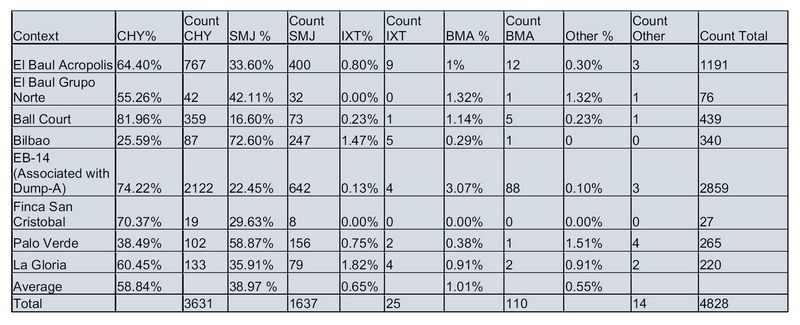 An
in-depth examination of obsidian from EB-14 was undertaken to
investigate distribution at a small scale. For the purposes of this
discussion the analyzed contexts will be divided into four areas: 1)
Structure E; 2) Unit Q1AA3; 3) Structures A and B; and 4) dump-A
(fig.14, Table 4). The first three contexts are very similar in their
relative source frequency, the sources of CHY and SMJ predominate the
assemblage accounting for 96% of the total. Chayal obsidian makes up
about three quarters of the nondump assemblage, while SMJ accounts for
just under a quarter. The paucity of SMJ obsidian recovered from
dump-A, suggests that this workshop did procure SMJ obsidian to produce
tools, but obtained finished SMJ blades through exchange with producers
elsewhere in Cotzumalhuapa or further afield.
An
in-depth examination of obsidian from EB-14 was undertaken to
investigate distribution at a small scale. For the purposes of this
discussion the analyzed contexts will be divided into four areas: 1)
Structure E; 2) Unit Q1AA3; 3) Structures A and B; and 4) dump-A
(fig.14, Table 4). The first three contexts are very similar in their
relative source frequency, the sources of CHY and SMJ predominate the
assemblage accounting for 96% of the total. Chayal obsidian makes up
about three quarters of the nondump assemblage, while SMJ accounts for
just under a quarter. The paucity of SMJ obsidian recovered from
dump-A, suggests that this workshop did procure SMJ obsidian to produce
tools, but obtained finished SMJ blades through exchange with producers
elsewhere in Cotzumalhuapa or further afield. Fig.14:
Pie charts of relative proportions of Obsidian sources present in
contexts of EB-14. BMA=San Bartolome Milpas Altas, CHY=El Chayal,
IXT=Ixtepeque; SMJ=San Martin Jilotepeque.
Fig.14:
Pie charts of relative proportions of Obsidian sources present in
contexts of EB-14. BMA=San Bartolome Milpas Altas, CHY=El Chayal,
IXT=Ixtepeque; SMJ=San Martin Jilotepeque.Interestingly, EB-14 has the highest frequency of BMA obsidian most of which are identifiable as thinning flakes. The particularly high percentage of BMA flakes at Structures A and B suggest the procurement of BMA material to produce projectile points at dump-A. The absence of Ixtepeque and other obsidian sources at dump-A suggest that all the blades produced at this workshop were of CHY obsidian.
Table 4: Percentages and counts of obsidian sources by context in EB-14.
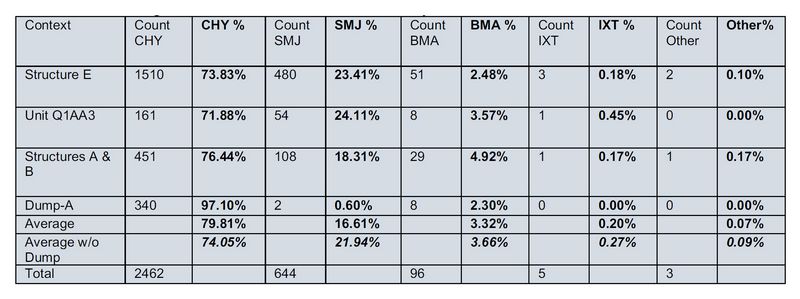
Flotation:
The flotation of samples from EB-14 has given us new insight into life at Cotzumalhuapa. This method was critical to collecting botanical samples suitable for radiocarbon dating to obtain a finegrained dating of the obsidian deposit. Suitable carbons samples were selected by identifying hardwoods with a DinoLite AM4815ZT portable microscope. Chronology at Cotzumalhuapa has primarily been done using ceramics and there is no radiocarbon data for any contexts at El Baúl (Chinchilla Mazariegos 1998).
Flotation also allowed for the collection of heavy fractions, which contained obsidian debitage,ceramics, and other small finds. Ceramic material was mostly unidentifiable but some diagnostic painted sherds and bead fragments were recovered. The obsidian heavy fraction represents the proof of production in the form of microdebitage, the very small flakes generated during craft production. They also serve as a representative sample which can be technologically classified, weighed by context, and then used to calculate probable quantities of technological classes present in unanalyzed material collected from matching contexts. This technique is necessary because the obsidian collected from certain matching contexts within Q4O3 can number in the tens to hundreds of thousands.
Additionally, prior to this year there had been no collection of botanical remains for study. The project is currently in the process of building a botanical reference collection from material collected from soil sample floatation light fractions.
A total of six botanical samples from five levels were selected for radiocarbon dating at the Beta Analytic laboratories in Miami, Florida. All of the samples confirm the Late Classic date for use of the obsidian dump, (Table 5). The dump was in use by the seventh century, and was being used until the ninth century demonstrating a long period of use. Additionally, these data suggest that a lens of compacted earth (see floor, Fig. 10) represent a major depositional event sealing off material below.
Table 5: Radiocarbon dates by context.
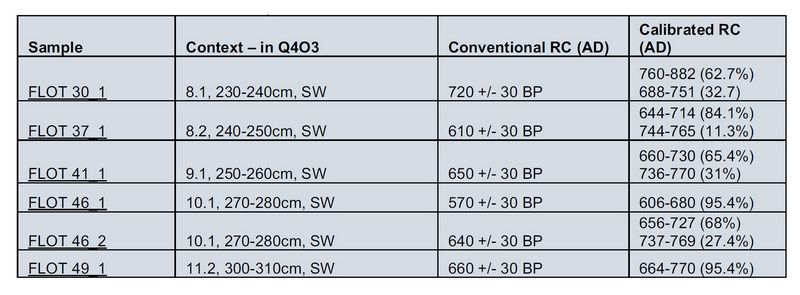
Conclusions:
Support from grant RFF-2018-83 during the 2018 season helped to produce a robust vision of zones related to the production of obsidian at Cotzumalhuapa during the Late Classic. A large sector located to the east of the El Baúl acropolis with evidence of production was investigated. According to ceramic data the buildings and built features were Late Classic in date, which was confirmed by radiocarbon dates. These dates, while not the first to date a major economic activity at the site, were the first to date any context at El Baúl. Excavations demonstrated considerable architectural elaboration in the form of stone-faced structures.
Artifacts associated with domestic activities, including spindle whorls and grinding stones were found in modest numbers. These were not found on top of floors and some examples may have been architectural fill, and many were intermingled in dump-A. The distribution of these artifacts suggests the area in and around Structures A and B were domestic in function. Dump-A is of particular interest, assuming it served as a repository of domestic activity and consumption. The assemblage demonstrates access to fine ceramics. Critically for the purposes of this project, it suggests that obsidian craft production occurred at or near Structures A and B. This is further supported by the abundance of obsidian recovered from the areas within and around these structures.
Comparison with materials recoveredfrom workshop dump-D, excavated in 2002, illuminates some important differences with the context excavated in 2018. First, the buildings immediately adjacent to dump-D were very simple, low platforms with little investment of labor, not suitable for habitation and domestic activity (Chinchilla Mazariegos 2011). However, approximately 30m from dump-D a group of considerably elaborate buildings were found, including two staircases similar to Structure E. Chinchilla Mazariegos (2006) also identified two structures as sweatbaths as well as numerous offerings and ritual artifacts. This group of buildings may have been part of an elite compound with specialized space designated for living, ritual, and craft production.
At EB-14 the concentration of obsidian is less dense and the architectural
group immediately adjacent to the dump is of the same fine construction near dump-D where Chinchilla encountered offerings in 2002-2007. As a representative sample of domestic architectural groups across the site has yet to be excavated, it is too early to characterize dump-A's architectural group as representative of a particular type of social group. On the one hand we should consider EB-14’s proximity to the acropolis of El Baúl, which may suggest that these people enjoyed an elevated social status. The quality of the construction and ceramics present supports this idea. It is important to complement the understanding of this context with analysis, albeit in process, of obsidian, botanical materials, and other samples recovered from EB-14. The analysis of lithic material offers details in the industries to which these (likely) households were engaged through patterns of procurement, production, and consumption of obsidian artifacts at Cotzumalhuapa.
References:
Castillo Taracena, Carlos Rafael
2006 Los Procesos de produccion litica en la costa sur guatemalteca: el deposito de artefactos de obsidiana del sitio El Baul, Santa Lucia Cotzumalguapa. Universidad de San Carlos, Escuela de Historia area de Arqueologia, Guatemala City.
Chinchilla Mazariegos, Oswaldo
1998 El Baúl: Un sitio defensivo en la zona nuclear de Cotzumalguapa. In XI Simposio de Investigaciones Arqueológicas en Guatemala, 1997, edited by J. P. Laporte and H. Escobedo, pp. 512-522. Museo Nacional de Arqueología y Etnología, Guatemala.
2006 Proyecto Arqueológico Cotzumalguapa. Informe de la Temporada 2006.
2011 The Obsidian Workshop of El Baul, Cotzumalguapa. In The Technology of Maya Civilization, edited by Z. Hruby, G. E. Braswell and O. Chinchilla Mazariegos, pp. 100-116. Routledge, New York.
2018 Technologies of urbanism in Mesoamerica: the pre-Columbian bridges of
Cotzumalhuapa, Guatemala. Antiquity 92(362):456-471.
Chinchilla Mazariegos, Oswaldo, Frederick J. Bove and José Vicente Genovez
2009 La Chronología del Periodo Clásico en la Costa Sur de Guatemala y el Fechamiento del Estilo Escultórico de Cotzumalguapa. In Cronología y Periodización en Mesoamerica y el Norte de México, edited by A. Deneels, pp. 435-472. Universidad Nacional Autónoma de México, Instituto de Investigaciones Antropológicas, Mexico City.
Chinchilla Mazariegos, Oswaldo and Edgar Carpio Rezzio
2003 Investigaciones en el Taller de Obsidiana de El Baúl, Zona Nuclear de Cotzumalguapa Informe Preliminar. In XVI Simposio de Investigaciones Arqueológicas en Guatemala, edited by J. P. Laporte and H. Escobedo, pp. 225-235. Museo Nacional de Arqueología y Etnología, Guatemala City.
Chinchilla Mazariegos, Oswaldo, Elisa Mencos, Jorge Cárcamo and José Vicente Genovez
2005 Paisaje y Asentamientos en Cotzumalguapa. Museo Popol Vuh, Universidad Francisco Marroquín., Guatemala City.
Clark, John E.
1997 Prismatic Blademaking, Craftsmanship, and Production. Ancient Mesoamerica 8(1):137- 159.
Clark, John E. and Douglas Donne Bryant
1997 A Technological Typology of Prismatic Blades and Debitage From Ojo de Agua,
Chiapas, Mexico. Ancient Mesoamerica 8(1):111-136.
Hirth, Kenneth G.
2006 Obsidian Craft Production in Ancient Central Mexico. University of Utah Press, Salt Lake City.
Hirth, Kenneth G., Bradford Andrews and J. Jeffery Flennicken
2006 A Technological Analysis of Xochicalco Obsidian Prismatic Blade Production. In Obsidian Craft Production in Central Mexico, edited by K. G. Hirth, pp. 63-95. University of Utah Press, Salt Lake City.
McCormick, David R.
2019 La obsidiana de Cotzumalhuapa: resultados del análisis tecnológico visual y geoquímico. In XXXII Simposio de Investigaciones Arqueológicas en Guatemala, 2018. Museo Nacional de Arqueología e Etnología, Guatemala City.
Parsons, Lee
1967 Bilbao, Guatemala: An Archaeological Study of the Pacific Coast Cotzumalhuapa Region. Milwaukee Public Museum Publications in Anthropology. vol. 1. Milwaukee Public Museum, Milwaukee.
Stark, Barbara, M. A. Boxt, J. Gasco, R. B. G. Lauck, J. D. H. Balkin, A. A. Joyce, S. M. King, C. L. Knight, R. Kruger, M. N. Levine and R. G. Lesure
2016 Economic growth in Mesoamerica: Obsidian consumption in the coastal lowlands. Journal of Anthropological Archaeology 41:263-282.
Thompson, J. Eric S.
1948 An Archaeological Reconnaissance in the Cotzumalhuapa Region, Escuintla,
Guatemala. Contributions to American Anthropology and History, 44. Carnegie Institution of Washington, Washington, D.C.:.
Recent Foundation grants: general Archaeology Grants Program w/map
Copyright © 2020 Rust Family Foundation